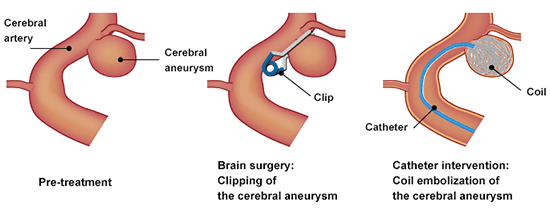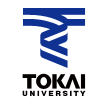- HOME
- For Patients
- Subarachnoid hemorrhage
- Treatment of subarachnoid hemorrhage
Subarachnoid hemorrhage
- About subarachnoid hemorrhage
- Symptom of subarachnoid hemorrhage
- Cause of subarachnoid hemorrhage
- Diagnosis of subarachnoid hemorrhage
- Treatment of subarachnoid hemorrhage
Treatment of subarachnoid hemorrhage
Surgery to prevent rebleeding
The greatest danger for patients with subarachnoid hemorrhage caused by cerebral aneurysm is recurrence (rebleeding). A ruptured cerebral aneurysm is susceptible to rebleeding (rerupture), and particular caution is required in the first 24 hours. Rerupture increases the amount of subarachnoid hemorrhage, making damage to the brain more serious and increasing the risk of death. To prevent such rerupture, surgical treatment is used to stop the flow of blood to the cerebral aneurysm. Surgery may be broadly divided into clipping, in which craniotomy is performed and the base of the aneurysm is closed with a metal clip similar to a clothespin, and coil embolization, in which a catheter is inserted as far as the aneurysm from a vessel in the groin (the femoral artery), and platinum coils are packed in. Both types of surgeries halt the flow of blood through the cerebral aneurysm; however, the method chosen will depend on the size and location of the aneurysm, as well as factors such as the age of the patient. At Tokai University, we continuously have a system in place for rapidly determining the best method of treatment (decided on the basis of symptoms, location of the aneurysm, and other factors).
[ Treatments for subarachnoid hemmorhage cause by a cerebral aneurysm ]

Once surgery has been performed to halt the flow of blood, full-scale treatment can be started for the subarachnoid hemorrhage. Hemorrhage through the subarachnoid space, through which the cerebral artery passes, not only causes brain damage, but also changes the cerebral artery. Blood vessels narrowing in so-called cerebrovascular spasm may cause inadequate blood flow to the brain, resulting in cerebral infarction. This phenomenon is commonly seen between 4 and 14 days after onset, and intensive care is required during this time. In addition to the damage caused by the subarachnoid hemorrhage, damage from a cerebral infarction increases the risks of both sequelae and death during this period. A range of treatment methods is used for patients during this time, but a decisive method for preventing such damage has yet to be found.
Rerupture and cerebrovascular spasm are a particular problem in more severe and serious cases, and opinion on their treatment is divided in some respects, even among specialists. At Tokai University, we proactively treat severe cases of subarachnoid hemorrhage, performing early surgery to stop blood flow and using various methods of treatment to prevent cerebral infarction. We aim to provide the best treatment possible for individual patients in accordance with their specific condition.







